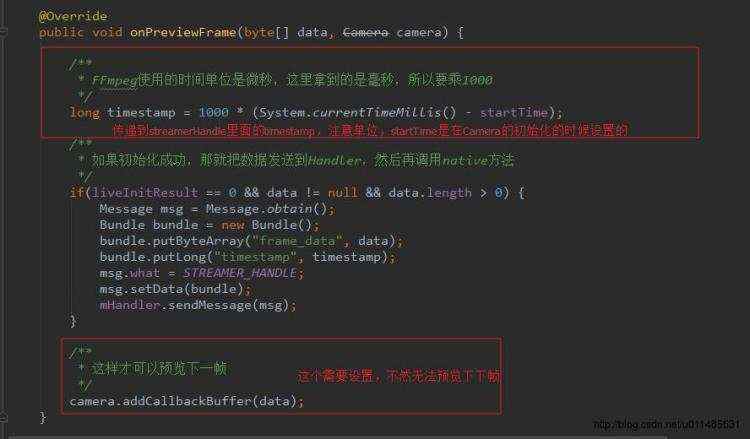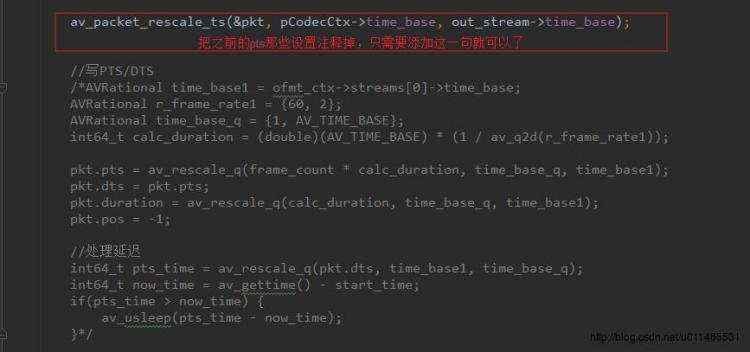篇首语:本文由编程笔记#小编为大家整理,主要介绍了最纯粹的直播技术实战03-通过filter进行旋转及卡顿修复相关的知识,希望对你有一定的参考价值。
这个系列的文章将会研究最纯粹的android直播的实现,而且不是用现在的集成SDK来达到直播的技术实现,而是从一个比较底层的直播实现来探讨这个技术,这样子对于直播技术的实现,现成的一些直播框架等都有一个比较好的理解。
上一篇文章把Camera的处理以及推流给实现了,但还留下了几个bug,这一篇文章就把一些bug处理一下,主要处理两个bug
如果没有看过之前的文章的可以戳这里
首先,先把画面颠倒的问题解决先,颠倒的话,我们可以通过多种方式完成,比如说从Camera里面获取到的NV21数据进行一个旋转的操作也可以,但这里,使用FFmpeg里的filter来完成,顺便学习一下filter的使用
FFmpeg的filter初始化起来非常的复杂,但初始化完成后,使用就非常的简单了。想要了解filter的强大功能,可以看看官方文档
那么我们需要使用filter,那就需要写一个初始化函数了
/**
* 初始化filter
*/
int init_filters(const char *filters_descr)
/**
* 注册所有AVFilter
*/
avfilter_register_all();
char args[512];
int ret = 0;
AVFilter *buffersrc = avfilter_get_by_name("buffer");
AVFilter *buffersink = avfilter_get_by_name("buffersink");
AVFilterInOut *outputs = avfilter_inout_alloc();
AVFilterInOut *inputs = avfilter_inout_alloc();
enum AVPixelFormat pix_fmts[] = AV_PIX_FMT_YUV420P, AV_PIX_FMT_NONE ;
//为FilterGraph分配内存
filter_graph = avfilter_graph_alloc();
if (!outputs || !inputs || !filter_graph)
ret = AVERROR(ENOMEM);
goto end;
/**
* 要填入正确的参数
*/
snprintf(args, sizeof(args),
"video_size=%dx%d:pix_fmt=%d:time_base=%d/%d:pixel_aspect=%d/%d",
src_width, src_height, pCodecCtx->pix_fmt,
pCodecCtx->time_base.num, pCodecCtx->time_base.den,
pCodecCtx->sample_aspect_ratio.num, pCodecCtx->sample_aspect_ratio.den);
//创建并向FilterGraph中添加一个Filter
ret = avfilter_graph_create_filter(&buffersrc_ctx, buffersrc, "in", args, NULL, filter_graph);
if (ret <0)
LOGE("Cannot create buffer source\\n");
goto end;
//创建并向FilterGraph中添加一个Filter
ret &#61; avfilter_graph_create_filter(&buffersink_ctx, buffersink, "out", NULL, NULL, filter_graph);
if (ret <0)
LOGE("Cannot create buffer sink\\n");
goto end;
ret &#61; av_opt_set_int_list(buffersink_ctx, "pix_fmts", pix_fmts, AV_PIX_FMT_NONE, AV_OPT_SEARCH_CHILDREN);
if (ret <0)
LOGE("Cannot set output pixel format\\n");
goto end;
outputs->name &#61; av_strdup("in");
outputs->filter_ctx &#61; buffersrc_ctx;
outputs->pad_idx &#61; 0;
outputs->next &#61; NULL;
inputs->name &#61; av_strdup("out");
inputs->filter_ctx &#61; buffersink_ctx;
inputs->pad_idx &#61; 0;
inputs->next &#61; NULL;
//将一串通过字符串描述的Graph添加到FilterGraph中
if ((ret &#61; avfilter_graph_parse_ptr(filter_graph, filters_descr, &inputs, &outputs, NULL)) <0)
LOGE("parse ptr error\\n");
goto end;
//检查FilterGraph的配置
if ((ret &#61; avfilter_graph_config(filter_graph, NULL)) <0)
LOGE("parse config error\\n");
goto end;
//缓存frame&#xff0c;用来保存filter后的frame
new_frame &#61; av_frame_alloc();
//uint8_t *out_buffer &#61; (uint8_t *) av_malloc(av_image_get_buffer_size(pCodecCtx->pix_fmt, pCodecCtx->width, pCodecCtx->height, 1));
//av_image_fill_arrays(new_frame->data, new_frame->linesize, out_buffer, pCodecCtx->pix_fmt, pCodecCtx->width, pCodecCtx->height, 1);
end:
avfilter_inout_free(&inputs);
avfilter_inout_free(&outputs);
return ret;
可以看到filter的初始化是挺麻烦的&#xff0c;但初始化完成后&#xff0c;只需要调用两个函数就可以很方便的使用了
//向FilterGraph中加入一个AVFrame
ret &#61; av_buffersrc_add_frame(buffersrc_ctx, yuv_frame);
if (ret >&#61; 0)
//从FilterGraph中取出一个AVFrame
ret &#61; av_buffersink_get_frame(buffersink_ctx, new_frame);
if (ret >&#61; 0)
ret &#61; encode(pCodecCtx, &pkt, new_frame, &got_packet);
else
LOGE("Error while getting the filtergraph\\n");
else
LOGE("Error while feeding the filtergraph\\n");
所以初始化麻烦&#xff0c;使用起来就很方便了。但是因为进行的旋转的操作&#xff0c;所以旋转后的frame的width和height就设置了&#xff0c;所以要对编码器的宽高进行修改&#xff0c;不然就无法编码成功

到这里&#xff0c;基本上就可以通过filter来把直播画面颠倒的问题给解决掉了。
那么就可以解决第二个问题就是直播卡顿的问题了&#xff0c;这个问题主要是因为pts/dts的设置问题
首先&#xff0c;我们要先把streamerHandle这个native方法修改一下&#xff0c;给它再添加一个参数&#xff0c;这个参数是用于设置pts的
/**
* 对每一次预览的数据进行编码推流
* &#64;param data NV21格式的数据
* &#64;param timestamp 用于设置pts
* &#64;return 0成功&#xff0c;小于0失败
*/
private native int streamerHandle(byte[] data, long timestamp);
在LiveActivity里面修改完成后&#xff0c;要刻去更新一下c里面对应的方法&#xff0c;不然就报错了
在这里&#xff0c;为了提高性能&#xff0c;我们可以把Camera的setPreviewCallback换成setPreviewCallbackWithBuffer&#xff0c;这样子就可以避免预览的时候&#xff0c;频繁创建byte[]和频繁的GC


那么把LiveActivity写好之后呢&#xff0c;我们就需要去到native层去设置好pts

av_packet_rescale_ts这个函数的主要作用就是&#xff1a;将packet中的有效定时字段&#xff08;timestamp/duration&#xff09;从一个time_base转换为另一个time_base
FFmpeg的time_base实际上就是指时间的刻度&#xff0c;
比如说当
time_base为1, 30的时候&#xff0c;如果pts为20&#xff0c;
那么要变成
time_base为1, 1000000刻度时的pts就要进行转换(20 * 1 / 30) / (1 / 1000000)
而且解码器那里有一个
time_base&#xff0c;编码器又有自己的time_base&#xff0c;所以当进行操作后&#xff0c;需要进行一个time_base的转换才行
设置完成这个之后&#xff0c;还需要用传递进来的timestamp计算也pts&#xff0c;并设置好

到这里&#xff0c;就基本上可以把直播画面卡顿的问题给解决掉了。
完整的native代码就如下&#xff1a;
//
// Created by Administrator on 2017/2/19.
//
#include
#include
#include
#include "libavcodec/avcodec.h"
#include "libavformat/avformat.h"
#include "libavutil/time.h"
#include "libavutil/imgutils.h"
#include "libavfilter/avfiltergraph.h"
#include "libavfilter/buffersink.h"
#include "libavfilter/buffersrc.h"
#include "libavutil/opt.h"
#define LOG_TAG "FFmpeg"
#define LOGE(format, ...) __android_log_print(ANDROID_LOG_ERROR, LOG_TAG, format, ##__VA_ARGS__)
#define LOGI(format, ...) __android_log_print(ANDROID_LOG_INFO, LOG_TAG, format, ##__VA_ARGS__)
AVFormatContext *ofmt_ctx &#61; NULL;
AVStream *out_stream &#61; NULL;
AVPacket pkt;
AVCodecContext *pCodecCtx &#61; NULL;
AVCodec *pCodec &#61; NULL;
AVFrame *yuv_frame;
int frame_count;
int src_width;
int src_height;
int y_length;
int uv_length;
int64_t start_time;
/**
* 定义filter相关的变量
*/
const char *filter_descr &#61; "transpose&#61;clock"; //顺时针旋转90度的filter描述
AVFilterContext *buffersink_ctx;
AVFilterContext *buffersrc_ctx;
AVFilterGraph *filter_graph;
int filterInitResult;
AVFrame *new_frame;
/**
* 回调函数&#xff0c;用来把FFmpeg的log写到sdcard里面
*/
void live_log(void *ptr, int level, const char* fmt, va_list vl)
FILE *fp &#61; fopen("/sdcard/123/live_log.txt", "a&#43;");
if(fp)
vfprintf(fp, fmt, vl);
fflush(fp);
fclose(fp);
/**
* 编码函数
* avcodec_encode_video2被deprecated后&#xff0c;自己封装的
*/
int encode(AVCodecContext *pCodecCtx, AVPacket* pPkt, AVFrame *pFrame, int *got_packet)
int ret;
*got_packet &#61; 0;
ret &#61; avcodec_send_frame(pCodecCtx, pFrame);
if(ret <0 && ret !&#61; AVERROR_EOF)
return ret;
ret &#61; avcodec_receive_packet(pCodecCtx, pPkt);
if(ret <0 && ret !&#61; AVERROR(EAGAIN))
return ret;
if(ret >&#61; 0)
*got_packet &#61; 1;
return 0;
/**
* 初始化filter
*/
int init_filters(const char *filters_descr)
/**
* 注册所有AVFilter
*/
avfilter_register_all();
char args[512];
int ret &#61; 0;
AVFilter *buffersrc &#61; avfilter_get_by_name("buffer");
AVFilter *buffersink &#61; avfilter_get_by_name("buffersink");
AVFilterInOut *outputs &#61; avfilter_inout_alloc();
AVFilterInOut *inputs &#61; avfilter_inout_alloc();
enum AVPixelFormat pix_fmts[] &#61; AV_PIX_FMT_YUV420P, AV_PIX_FMT_NONE ;
//为FilterGraph分配内存
filter_graph &#61; avfilter_graph_alloc();
if (!outputs || !inputs || !filter_graph)
ret &#61; AVERROR(ENOMEM);
goto end;
/**
* 要填入正确的参数
*/
snprintf(args, sizeof(args),
"video_size&#61;%dx%d:pix_fmt&#61;%d:time_base&#61;%d/%d:pixel_aspect&#61;%d/%d",
src_width, src_height, pCodecCtx->pix_fmt,
pCodecCtx->time_base.num, pCodecCtx->time_base.den,
pCodecCtx->sample_aspect_ratio.num, pCodecCtx->sample_aspect_ratio.den);
//创建并向FilterGraph中添加一个Filter
ret &#61; avfilter_graph_create_filter(&buffersrc_ctx, buffersrc, "in", args, NULL, filter_graph);
if (ret <0)
LOGE("Cannot create buffer source\\n");
goto end;
ret &#61; avfilter_graph_create_filter(&buffersink_ctx, buffersink, "out", NULL, NULL, filter_graph);
if (ret <0)
LOGE("Cannot create buffer sink\\n");
goto end;
ret &#61; av_opt_set_int_list(buffersink_ctx, "pix_fmts", pix_fmts, AV_PIX_FMT_NONE, AV_OPT_SEARCH_CHILDREN);
if (ret <0)
LOGE("Cannot set output pixel format\\n");
goto end;
outputs->name &#61; av_strdup("in");
outputs->filter_ctx &#61; buffersrc_ctx;
outputs->pad_idx &#61; 0;
outputs->next &#61; NULL;
inputs->name &#61; av_strdup("out");
inputs->filter_ctx &#61; buffersink_ctx;
inputs->pad_idx &#61; 0;
inputs->next &#61; NULL;
//将一串通过字符串描述的Graph添加到FilterGraph中
if ((ret &#61; avfilter_graph_parse_ptr(filter_graph, filters_descr, &inputs, &outputs, NULL)) <0)
LOGE("parse ptr error\\n");
goto end;
//检查FilterGraph的配置
if ((ret &#61; avfilter_graph_config(filter_graph, NULL)) <0)
LOGE("parse config error\\n");
goto end;
new_frame &#61; av_frame_alloc();
//uint8_t *out_buffer &#61; (uint8_t *) av_malloc(av_image_get_buffer_size(pCodecCtx->pix_fmt, pCodecCtx->width, pCodecCtx->height, 1));
//av_image_fill_arrays(new_frame->data, new_frame->linesize, out_buffer, pCodecCtx->pix_fmt, pCodecCtx->width, pCodecCtx->height, 1);
end:
avfilter_inout_free(&inputs);
avfilter_inout_free(&outputs);
return ret;
JNIEXPORT jstring JNICALL
Java_com_xiaoxiao_live_MainActivity_helloFromFFmpeg(JNIEnv *env, jobject instance)
// TODO
char info[10000] &#61; 0;
sprintf(info, "%s\\n", avcodec_configuration());
return (*env)->NewStringUTF(env, info);
JNIEXPORT jint JNICALL
Java_com_xiaoxiao_live_LiveActivity_streamerRelease(JNIEnv *env, jobject instance)
// TODO
if(pCodecCtx)
avcodec_close(pCodecCtx);
pCodecCtx &#61; NULL;
if(ofmt_ctx)
avio_close(ofmt_ctx->pb);
if(ofmt_ctx)
avformat_free_context(ofmt_ctx);
ofmt_ctx &#61; NULL;
if(yuv_frame)
av_frame_free(&yuv_frame);
yuv_frame &#61; NULL;
if(filter_graph)
avfilter_graph_free(&filter_graph);
filter_graph &#61; NULL;
if(new_frame)
av_frame_free(&new_frame);
new_frame &#61; NULL;
JNIEXPORT jint JNICALL
Java_com_xiaoxiao_live_LiveActivity_streamerFlush(JNIEnv *env, jobject instance)
// TODO
int ret;
int got_packet;
AVPacket packet;
if(!(pCodec->capabilities & CODEC_CAP_DELAY))
return 0;
while(1)
packet.data &#61; NULL;
packet.size &#61; 0;
av_init_packet(&packet);
ret &#61; encode(pCodecCtx, &packet, NULL, &got_packet);
if(ret <0)
break;
if(!got_packet)
ret &#61; 0;
break;
LOGI("Encode 1 frame size:%d\\n", packet.size);
AVRational time_base &#61; ofmt_ctx->streams[0]->time_base;
AVRational r_frame_rate1 &#61; 60, 2;
AVRational time_base_q &#61; 1, AV_TIME_BASE;
int64_t calc_duration &#61; (double)(AV_TIME_BASE) * (1 / av_q2d(r_frame_rate1));
packet.pts &#61; av_rescale_q(frame_count * calc_duration, time_base_q, time_base);
packet.dts &#61; packet.pts;
packet.duration &#61; av_rescale_q(calc_duration, time_base_q, time_base);
packet.pos &#61; -1;
frame_count&#43;&#43;;
ofmt_ctx->duration &#61; packet.duration * frame_count;
ret &#61; av_interleaved_write_frame(ofmt_ctx, &packet);
if(ret <0)
break;
//写文件尾
av_write_trailer(ofmt_ctx);
return 0;
JNIEXPORT jint JNICALL
Java_com_xiaoxiao_live_LiveActivity_streamerHandle(JNIEnv *env, jobject instance,
jbyteArray data_, jlong timestamp)
jbyte *data &#61; (*env)->GetByteArrayElements(env, data_, NULL);
// TODO
int ret, i, resultCode;
int got_packet &#61; 0;
resultCode &#61; 0;
/**
* 这里就是之前说的NV21转为AV_PIX_FMT_YUV420P这种格式的操作了
*/
memcpy(yuv_frame->data[0], data, y_length);
for (i &#61; 0; i
*(yuv_frame->data[1] &#43; i) &#61; *(data &#43; y_length &#43; i * 2 &#43; 1);
yuv_frame->format &#61; pCodecCtx->pix_fmt;
yuv_frame->width &#61; src_width;
yuv_frame->height &#61; src_height;
//yuv_frame->pts &#61; frame_count;
//yuv_frame->pts &#61; (1.0 / 30) * 90 * frame_count;
yuv_frame->pts &#61; timestamp * 30 / 1000000;
pkt.data &#61; NULL;
pkt.size &#61; 0;
av_init_packet(&pkt);
if (filterInitResult >&#61; 0)
ret &#61; 0;
//向FilterGraph中加入一个AVFrame
ret &#61; av_buffersrc_add_frame(buffersrc_ctx, yuv_frame);
if (ret >&#61; 0)
//从FilterGraph中取出一个AVFrame
ret &#61; av_buffersink_get_frame(buffersink_ctx, new_frame);
if (ret >&#61; 0)
ret &#61; encode(pCodecCtx, &pkt, new_frame, &got_packet);
else
LOGE("Error while getting the filtergraph\\n");
else
LOGE("Error while feeding the filtergraph\\n");
if(filterInitResult <0 || ret <0)
LOGE("encode from yuv data");
/**
* 因为通过filter后&#xff0c;packet的宽高已经改变了&#xff0c;初始化的编码器已经无法使用了&#xff0c;
* 所以要兼容filter无法初始化的话&#xff0c;需要重新初始化一个对应宽高的编码器
*/
//进行编码
//ret &#61; encode(pCodecCtx, &pkt, yuv_frame, &got_packet);
if(ret <0)
resultCode &#61; -1;
LOGE("Encode error\\n");
goto end;
if(got_packet)
LOGI("Encode frame: %d\\tsize:%d\\n", frame_count, pkt.size);
frame_count&#43;&#43;;
pkt.stream_index &#61; out_stream->index;
//将packet中的有效定时字段&#xff08;timestamp/duration&#xff09;从一个time_base转换为另一个time_base
av_packet_rescale_ts(&pkt, pCodecCtx->time_base, out_stream->time_base);
//写PTS/DTS
/*AVRational time_base1 &#61; ofmt_ctx->streams[0]->time_base;
AVRational r_frame_rate1 &#61; 60, 2;
AVRational time_base_q &#61; 1, AV_TIME_BASE;
int64_t calc_duration &#61; (double)(AV_TIME_BASE) * (1 / av_q2d(r_frame_rate1));
pkt.pts &#61; av_rescale_q(frame_count * calc_duration, time_base_q, time_base1);
pkt.dts &#61; pkt.pts;
pkt.duration &#61; av_rescale_q(calc_duration, time_base_q, time_base1);
pkt.pos &#61; -1;
//处理延迟
int64_t pts_time &#61; av_rescale_q(pkt.dts, time_base1, time_base_q);
int64_t now_time &#61; av_gettime() - start_time;
if(pts_time > now_time)
av_usleep(pts_time - now_time);
*/
ret &#61; av_interleaved_write_frame(ofmt_ctx, &pkt);
if(ret <0)
LOGE("Error muxing packet");
resultCode &#61; -1;
goto end;
av_packet_unref(&pkt);
end:
(*env)->ReleaseByteArrayElements(env, data_, data, 0);
return resultCode;
JNIEXPORT jint JNICALL
Java_com_xiaoxiao_live_LiveActivity_streamerInit(JNIEnv *env, jobject instance, jint width,
jint height)
// TODO
int ret &#61; 0;
const char *address &#61; "rtmp://192.168.1.102/oflaDemo/test";
src_width &#61; width;
src_height &#61; height;
//yuv数据格式里面的 y的大小&#xff08;占用的空间&#xff09;
y_length &#61; width * height;
//u/v占用的空间大小
uv_length &#61; y_length / 4;
//设置回调函数&#xff0c;写log
av_log_set_callback(live_log);
//激活所有的功能
av_register_all();
//推流就需要初始化网络协议
avformat_network_init();
//初始化AVFormatContext
avformat_alloc_output_context2(&ofmt_ctx, NULL, "flv", address);
if(!ofmt_ctx)
LOGE("Could not create output context\\n");
return -1;
//寻找编码器&#xff0c;这里用的就是x264的那个编码器了
pCodec &#61; avcodec_find_encoder(AV_CODEC_ID_H264);
if(!pCodec)
LOGE("Can not find encoder!\\n");
return -1;
//初始化编码器的context
pCodecCtx &#61; avcodec_alloc_context3(pCodec);
pCodecCtx->pix_fmt &#61; AV_PIX_FMT_YUV420P; //指定编码格式
pCodecCtx->width &#61; height;
pCodecCtx->height &#61; width;
pCodecCtx->time_base.num &#61; 1;
pCodecCtx->time_base.den &#61; 30;
pCodecCtx->bit_rate &#61; 800000;
pCodecCtx->gop_size &#61; 300;
if(ofmt_ctx->oformat->flags & AVFMT_GLOBALHEADER)
pCodecCtx->flags |&#61; CODEC_FLAG_GLOBAL_HEADER;
pCodecCtx->qmin &#61; 10;
pCodecCtx->qmax &#61; 51;
pCodecCtx->max_b_frames &#61; 3;
AVDictionary *dicParams &#61; NULL;
av_dict_set(&dicParams, "preset", "ultrafast", 0);
av_dict_set(&dicParams, "tune", "zerolatency", 0);
//打开编码器
if(avcodec_open2(pCodecCtx, pCodec, &dicParams) <0)
LOGE("Failed to open encoder!\\n");
return -1;
//新建输出流
out_stream &#61; avformat_new_stream(ofmt_ctx, pCodec);
if(!out_stream)
LOGE("Failed allocation output stream\\n");
return -1;
out_stream->time_base.num &#61; 1;
out_stream->time_base.den &#61; 30;
//复制一份编码器的配置给输出流
avcodec_parameters_from_context(out_stream->codecpar, pCodecCtx);
//打开输出流
ret &#61; avio_open(&ofmt_ctx->pb, address, AVIO_FLAG_WRITE);
if(ret <0)
LOGE("Could not open output URL %s", address);
return -1;
ret &#61; avformat_write_header(ofmt_ctx, NULL);
if(ret <0)
LOGE("Error occurred when open output URL\\n");
return -1;
//初始化一个帧的数据结构&#xff0c;用于编码用
//指定AV_PIX_FMT_YUV420P这种格式的
yuv_frame &#61; av_frame_alloc();
uint8_t *out_buffer &#61; (uint8_t *) av_malloc(av_image_get_buffer_size(pCodecCtx->pix_fmt, src_width, src_height, 1));
av_image_fill_arrays(yuv_frame->data, yuv_frame->linesize, out_buffer, pCodecCtx->pix_fmt, src_width, src_height, 1);
start_time &#61; av_gettime();
/**
* 初始化filter
*/
filterInitResult &#61; init_filters(filter_descr);
if(filterInitResult <0)
LOGE("Filter init error");
return 0;
那么&#xff0c;到这里就可以把上面说的两个问题给解决掉了&#xff0c;但还是有一定的延迟&#xff08;还在找原因&#xff09;&#xff0c;而且当摄像头切换成前摄像头的时候&#xff0c;会发现画面还是颠倒的&#xff0c;因为前摄像头需要顺时针旋转270度才行的&#xff0c;那么这时候就会发现filter在处理这个旋转的时候有点局限性了。因为filter初始化太麻烦了&#xff0c;所以用filter来解决这个直播画面颠倒的问题有点麻烦。所以就需要使用另外的方法来解决这个问题了。
那么就应该在编码前就把预览的数据给旋转过来&#xff0c;为了以后后续的扩展&#xff0c;比如说加上美颜功能这些&#xff0c;那就需要在预览前就要对数据进行修改再预览&#xff0c;那就SurfaceView就无法满足这个要求那就需要需要TextureView或GLSurfaceView了。这两个都可以在预览前拿到数据&#xff0c;再自己绘制出来的&#xff0c;GLSurfaceView功能更加强大&#xff0c;所以就可以使用它了
所以现在还有的问题就是&#xff1a;
这些问题都需要后续解决的&#xff0c;所以下一篇文章就使用GLSurfaceView来代替filter解决直播画面颠倒的问题

 京公网安备 11010802041100号 | 京ICP备19059560号-4 | PHP1.CN 第一PHP社区 版权所有
京公网安备 11010802041100号 | 京ICP备19059560号-4 | PHP1.CN 第一PHP社区 版权所有